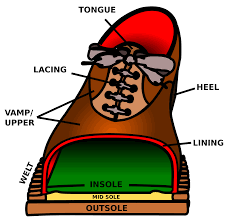Everybody knows what a shoe is, even though the term covers a fairly broad variety of footwear. What is less commonly known are what all the various parts that make up a shoe are called – in other words, the shoe’s anatomy.
 This can be particularly useful to know when shopping for shoes online, or dealing with customer service issues via email or the like. If you can’t bring the actual shoe in to the store, or speak on the phone, you need to be able to accurately describe what it is you want to buy or need fixed. For example, if you know your shoe anatomy, you could write “the vamp of my right shoe has detached from the toe” when raising a complaint with a shoe retailer.
This can be particularly useful to know when shopping for shoes online, or dealing with customer service issues via email or the like. If you can’t bring the actual shoe in to the store, or speak on the phone, you need to be able to accurately describe what it is you want to buy or need fixed. For example, if you know your shoe anatomy, you could write “the vamp of my right shoe has detached from the toe” when raising a complaint with a shoe retailer.
Below is a video we found that we thought was quite good as an introduction.
Shoe Structure
A shoe’s structure can generally be divided into upper and lower parts.
The upper part of a shoe refers to all the parts of the shoe above the sole. This is further sub-divided into the vamp (the front of the shoe), the quarters (the back and side of the shoe) and the linings.
The lower part of the shoe refers to the sole, the shank and the heel.
Read below for more details about the terminology used in describing a shoe’s anatomy. Note that not all terms necessarily apply to all shoes, as styles and types of shoes vary.
Shoe Terminolgy
Breast:
The front part of the heel below the arch of the sole
Collar
The stitching that forms the rim of a shoe or boot
Eyelet
The holes that shoelaces pass through.
Feather:
Where the upper part of the shoe meets the sole
Heel:
 The part of the sole that raises the back of the shoe. Although used predominantly for improved balance on a shoe, the sole’s shape and size can effect posture and the perceived height of the wearer. Heels play a major part in design fashions for shoes.
The part of the sole that raises the back of the shoe. Although used predominantly for improved balance on a shoe, the sole’s shape and size can effect posture and the perceived height of the wearer. Heels play a major part in design fashions for shoes.
The heel is the part of the sole that raises the rear of the shoe in relation to the front. The heal seat is the top of the heal that touches the upper, this is typically shaped to match the form of the upper. The part of the the heel that comes in contact with the ground is known as the the top piece.
Heel Collar
The top part of the quarters providing support for the heel and helping prevent the foot from slipping inside the shoe.
Heel Counter
An insert (usually plastic) used to re-inforce the heel cup of a shoe and help with foot support.
Heel Seat
The top of the heel that touches the upper part of the shoe.
Insole:
A removable sole that is placed inside the shoe between the sole and the foot. Typically used to improve a fit, for comfort, for warmth or as a deodorizer.
Linings:
The material inside the shoe that directly contacts the foot (or the sock!). Designed to increase comfort and lengthen the lifespan of the shoe.
Outsole:
The bottom of the sole that comes in direct contact with the ground. The outsoles of shoes are made from a variety of materials depending often on the purpose of the shoe.
Puff:
Placed between the lining and the upper shoe ,the puff gives support and shape to the toe.
Quarter:
The sides and back of the upper shoe, behind the vamp.
Some shoes are whole cut, meaning that the quarter and the vamp are made from the same piece of material. However in most shoes, the quarter and vamp will be two separate pieces of material.
Seat:
Where the heel of the fit sits in the shoe. It normally matches the shape of the heel for comfort and support.
Shank:
A piece of metal inserted between the sole and the insole lying against the arch of the foot.
Sole:
The part of the lower shoe that sits beneath the wearer’s foot. Often used to describe the entire lower part of the shoe, though technically the heel is not part of the sole.
Throat:
The front of the vamp next to the toe cap.
Toe cap:
A piece of steel or leather that is placed over the front part of a boot or shoe for added protection or re-enforcement.
Top Piece:
The bottom of the heel that comes in direct contact with the ground. Usually made of durable material.

Toungue
A strip of material that sits on top of the center part of a shoe but underneath the laces. The tongue is attached to the vamp and runs all the way to the hroat, making it easier to take your shoes on and off. Shoes without laces do not have toungues.
Upper:
The entire part of the shoe above the sole.
Vamp:
The section of upper that covers the front of the foot from the toe and extending around the tongue and eyelets to the back of the shoe.
Waist:
The arch and in-step of the foot.
Welt:
A strip of material that joins the upper to the sole.